In this article: the history of the creation of a compact fluorescent lamp; its structure and operating principle; spectrum of energy-saving lamps depends on the composition of the phosphor; pluses and minuses of energy-saving fluorescent lamps; how to choose an energy saving lamp.
The ban on the sale and production in Russia of the incandescent lamps familiar to us gave rise to a number of persistent rumors around energy-saving lamps. For the ordinary consumer, as we are with you, the main task of lighting devices was and is the quality itself lighting . And, of course, I do not want to incur unnecessary expenses for the purchase of these "new-fangled" lamps, because they are much more expensive than Ilyich's bulbs. Consider the characteristics of energy-saving lamps in this article.
History of creation
Officially, the first fluorescent or, as it is also called, fluorescent lamp was created at the beginning of the last century by an engineer-inventor from the US, Peter Cooper Hewitt, who received a patent for it on September 17, 1901. Although some researchers dispute his primacy in the invention, calling the "father" of the fluorescent lamp of the little-known German physicist Martin Arons, who experimented with mercury lamps at the end of the 19th century.
Invented and patented Hewitt fluorescent lamp contained mercury, whose vapors were heated by an electric current passed through it. Hewitt's lamp was spherical and slightly curved, it gave more light than Lodygin-Edison lamps, but this light was bluish-green, unpleasant for the eye. For this reason, the first mercury lamps were used only by photographers and they were not widely used.
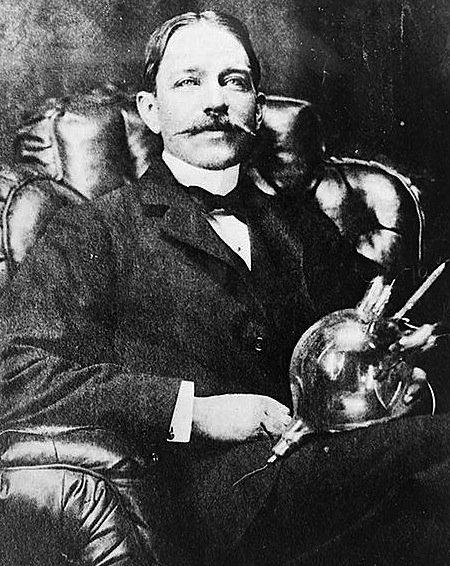
Peter Cooper Hewitt. 1861-1921
The fluorescent lamp in its practically modern form was created by a group of German inventors led by Edmund Germer, who patented their invention on December 10, 1926. It was Germer who came up with the idea of applying a fluorescent coating on the glass surface of the lamp from the inside, which converted the ultraviolet glow of the mercury lamp into white light, not cutting the eye. Albert Hull, an engineer at General Electric, developed a fluorescent lamp with a similar coating by the beginning of 1927, but the company was forced to purchase Edmund Germer's patent as having issued it earlier.
Since the acquisition of Germer's patent, General Electric engineers have been actively engaged in improving fluorescent lamps, trying to bring them to serial production. To reduce the size of the bulb, round and U-shaped lamps were created, demonstrated at the GE stand at the world's New York exhibition in 1939, lamps with a compact spiral bulb designed by General Electric's Edward Hammer in 1976. However, spiral-shaped fluorescent lamps in the 80s were never put into production, as the company's executives considered the costs of building new factories excessive. In 1995, the slowness of "General Electric" was taken advantage of by Chinese manufacturers, setting up the production of energy-saving lamps with spiral flasks.
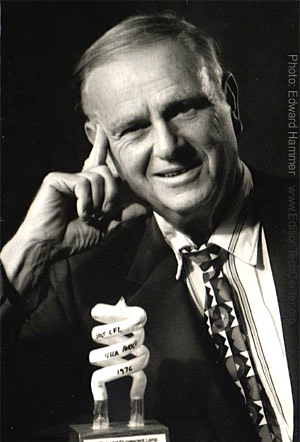
Edward Hammer with his invention - a lamp with a compact spiral bulb
The screw-in lamp with magnetic ballast (SL) was created by Philips in 1980 - it became the first fluorescent lamp of this kind, capable of competing with incandescent lamps. Energy saving lamp with electronic ballast (CFL) in 1985 was first demonstrated by the German concern Osram.
The main structural elements of the fluorescent lamp are a bulb, electronic ballast and cap. The threaded base for screwing into the lamp holder and with the contacts for its supply is practically the same as that of a conventional incandescent lamp.
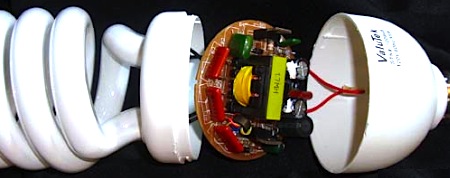
The curved bulb of the fluorescent lamp is coated with phosphor layers, filled with an inert gas and, in a small amount, with mercury vapor - ionizing them and causing the lamp to glow when the power is connected. The mercury content in fluorescent lamps is from 1 to 70 mg. Inside the bulb there are tungsten electrodes coated with a mixture of oxides of barium, calcium, zinc and strontium. The phosphor deposited on the inner surface of a glass bulb in compact fluorescent lamps contains alkaline earth metals, and is therefore 40% more expensive than the phosphors used in oblong fluorescent lamps for ceiling luminaires. Alkaline earth metals in the phosphor of compact lamps provide operation at high irradiation intensity, due to them it became possible to reduce the diameter of the lamp bulb. The bizarrely curved shape of the bulb in fluorescent lamps makes it possible to reduce its length by dividing into several short sections communicating with each other.
In themselves, lamps coated with phosphor and containing mercury vapor, will not work when the power is connected - a ballast starter built into the lamp between the cap and the bulb is required. Consuming a high-frequency current of the order of 50 kHz, electronic ballast (CFL) eliminates the effect of flickering energy-saving lamps, while increasing the production of light. High-frequency current electronic ballast increases for itself - it contains an inverter in its circuit. Also, the tasks of ballast include heating the electrodes and maintaining the power of the fluorescent lamp at a nominal level, regardless of the voltage drops in the network. The life of an energy-saving lamp depends on the quality of the electronic ballast.
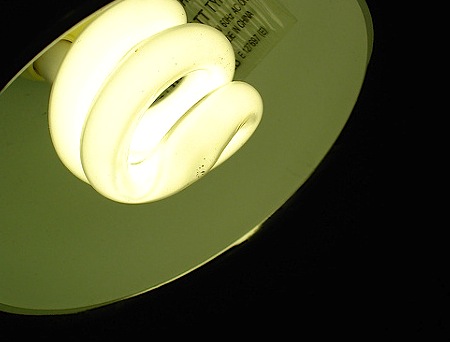
How does the fluorescent lamp work? Power supply causes a discharge between the electrodes, current passes through a mixture of inert gas and mercury vapor, fast electrons collide with slow mercury atoms - the lamp lights up. However, 98% of the light produced by the energy-saving lamp is ultraviolet, invisible to the human eye. And the visible light coming from it is provided by the layers of the phosphor luminescent under the influence of ultraviolet irradiation. The color of the illumination produced by fluorescent lamps depends on the chemical composition of the phosphor applied to the glass bulb from the inside.
Dependence of the visible spectrum of a fluorescent lamp on the phosphor
The light generated by cheap energy saving lamps is most often unpleasant for the eyesight - its spectrum is dominated by blue and yellow colors, as a result, the color of objects in the illuminated room is unnatural. The reasons are hidden in the type of phosphor, containing inexpensive calcium halophosphate. Such lamps, having a high luminous efficiency, are intended for illumination of non-residential premises (warehouses, etc.) - externally produce white light, but its reflection from objects reveals an incomplete spectrum (absence of red and green colors).
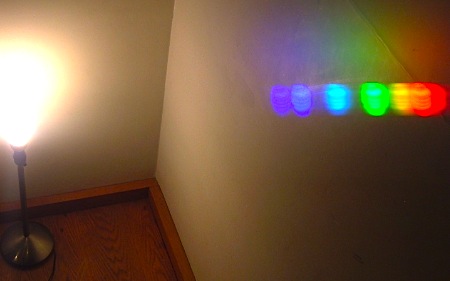
Energy saving lamps for home lighting have a higher price; the phosphor in them creates 3-5 color bands (for example red, green and blue) from the spectrum visible to the human eye and simulates the effect of natural light, but reduces the light output.
Immediately it is worth mentioning that the positive characteristics given below depend on the manufacturer of this lamp - his desire to save on raw materials and components seriously reduces the quality and life of fluorescent lamps.
pros energy saving lamps:
- much less compared to incandescent lamps, the consumption of electricity at a greater light output. If a 100 W incandescent lamp has a light output of 100-150 lumens, then the luminous efficiency of a 20 W fluorescent lamp will be 1 100-2 000 lumens - the difference is obvious. Low power consumption of energy-saving lamps, among other things, significantly reduces the load on wiring;
- a significant service life, 8-10 times the service life of incandescent lamps. When working an average of 2.5-3 hours a day, the fluorescent lamp will illuminate the room 8 000-11 000 hours and will last several years (depending on the model and manufacturer), about 6-8 times longer than the usual "Ilyich's lamp";
- during the entire working life the intensity of illumination by compact fluorescent lamps does not change;
- the maximum temperature of the operating energy-saving lamp will not exceed 60 ° C. 95% of the energy in incandescent lamps goes to heating, i.e. at a power of 100 W the incandescent lamp will be heated to 95 ° C;
- lamps of several light shades of illumination are produced, the main ones are warm daylight (similar to the color of illumination from incandescent lamps), daylight and cold daylight;
- in the produced light flux there is no flickering (stroboscopic effect), the stability of the lighting is provided by the electronic ballast of the lamp;
- factory warranty from the manufacturer for each energy-saving lamp. I've never had any guarantees for "Ilyich's lamps."
Minuses energy saving lamps:
- high price. If incandescent lamps cost 10-25 rubles, then fluorescent lamps will cost 80-400 rubles. Chinese and domestic energy-saving lamps are cheaper, European - more expensive;
- the ledge on the base, where the ballast of the lamp is located, sometimes prevents it from being installed. Do not look a lamp with electronic ballast and when installing it in a chandelier, tk. too noticeable socle;
- for warming up to a full brightness of the light emission, these lamps are required from 30 seconds to two minutes;
- the working life of compact fluorescent lamps depends on the frequency of turning on and turning off the power - the more often this happens, the faster the lamp will fail. Between disconnection and reclosing it is necessary to maintain a pause of at least 5 minutes;
- such lamps can not be used by people who have skin diseases and epilepsy, the intensity of illumination of energy-saving lamps is higher than usual and can lead to negative consequences;
- do not break the glass bulb of the lamp. the mercury vapor will enter the premises and they will have to be ventilated at any time of the year for several hours, and residents will have to leave the premises of the house (apartment) for the entire duration of the ventilation - this is important. If several lamps are broken down at once - it will be necessary to call specialists of the Ministry for Emergency Situations to carry out demercurization. Do not break the fluorescent lamps;
- it is not at all clear how to dispose of failed fluorescent lamps - they are not allowed to be thrown into scrap, but there are no specialized reception points in most settlements.
How to choose an energy-saving lamp
First of all, make sure the integrity of the lamp offered by the seller, the reliable connection of the bulb to the socle - a weak connection is usually made by the lamps of small Chinese manufacturers assembled manually.
The power of a new lamp is determined by the power of incandescent lamps previously used in this room with a reduction of 4-5 times. Those. if "Ilich's lamps" were used in 100 W, a fluorescent lamp of 20-25 W would be needed (better to take with a small margin of power).
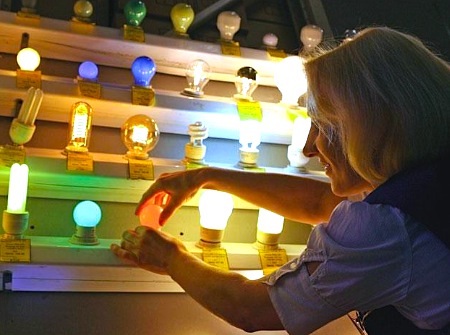
The intensity of illumination of this lamp is determined in the Kelvin temperature indicated on its packaging: from 2 700 to 4 000 ° C - warm light (analogue of the light from incandescent lamps), such lamps are suitable for lighting bedrooms and kitchens; from 4 000 to 5 000 OK - warm white light, suitable for living rooms and halls; from 6 000 to 6 500 ok - cold white light, used for office rooms and offices. Lamps of the latter type for lighting houses should not be purchased - the light is too saturated, difficult to tolerate.
The size of the lamp. The base of fluorescent lamps, as noted above, has a longer length than the base of incandescent lamps. For home lighting, the standard E27 base (length - 105 mm, diameter - 60 mm), whose dimensions are similar to the bullets for "Ilich lamps", will be optimal.
Guarantee and service life. They are indicated by the manufacturers on the packaging: the optimal operating time in the range of 6 000-12 000 hours; warranty - from a year or more. Please note that far from all brands of fluorescent lamps, the stated deadlines will be valid - Chinese manufacturers can specify high terms, but in fact the lamps will fail much earlier.
Manufacturers and brands. On the Russian market are energy-saving lamps of European brands - German "Osram" and "Wolta", Netherlands "Philips", Danish "Comtech", Polish "Ikea", American "General Electric"; Russian - Ecola, Kosmos, Aladin, Lisma, Uniel; Chinese, Camelion, Navigator, etc. Of course, the products of the largest European manufacturers are of high quality and performance, but it should be noted that compact fluorescent lamps of domestic production also have a good quality at a lower cost.
In custody
As can be seen from this article, fluorescent lamps really save electricity and properly serve, provided that the requirements for their operation are met. High cost and some mercury vapor content, of course, remain a problem for consumers, but manufacturers are trying to solve them - for example, in modern models of energy-saving lamps, mercury is bound by calcium amalgam and will not evaporate, according to the manufacturers, if the lamp is damaged.
Another way to save energy and guarantee to exclude the penetration of mercury vapors into residential premises will be the use of LED lamps, but this topic is for a separate article.
Abdyuzhanov Rustam, rmnt.ru
Represented by linear products, as well as luminescent compact. The latter are low-pressure gas discharge devices containing mercury. Among other things, we can distinguish LED lamps, which act as environmentally friendly. The unifying property is that these lighters allow saving energy, have a high light output, if compared with conventional incandescent lamps. All about you should know even before shopping. You must be prepared for the fact that in the very near future you will have to abandon incandescent lamps, as the government sets the course for the exploitation of energy-saving technologies.
Varieties of fluorescent compact lamps
In order to decide which device to choose, you should consider the types of socles. How to choose a light bulb? You can find out the information provided in the article. You should pay attention to the compact ones. They can be classified depending on the components. For example, on the base of such devices can be 2D, they are designed for decorative and hermetic lighting, including showers. G23 are used for bathrooms, shower and wall lamps. G24Q3, G24Q1, 2G7, G24Q2 are designed for household and industrial devices. Considering the types of energy-saving lamps, you pay attention to the G53, they are operated as energy-saving lamps for spotlights.
The most common socle is E27, it is made for a conventional cartridge, but the E40 is a socle for a large cartridge. If you have a lamp with E27 or E14 socks in front of you, then you can use it for conventional devices with traditional cartridges. They are most easily installed in traditional lamps. The figures listed above correspond to the thread diameter in conventional units. The declared period of their operation can be a limit of 3000 to 15 000 hours. Under such cartridges, lamps are produced that have a diffuser or an open tube.
Varieties by the color of radiation and form
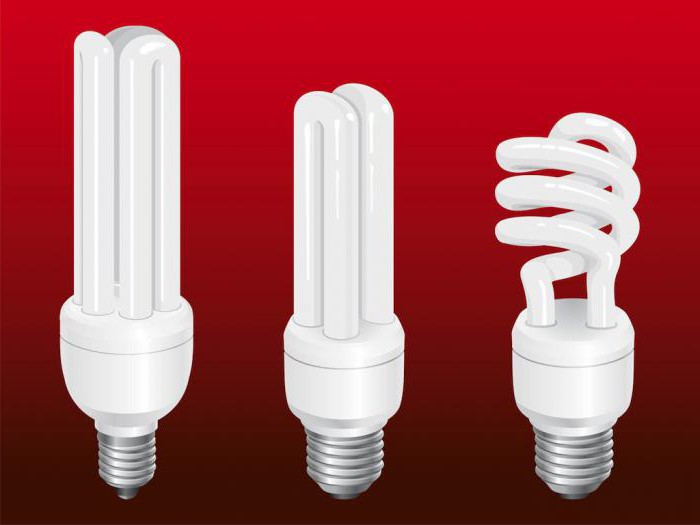
Considering in the store the types of energy-saving lamps, you can choose from the above-described products also in color, the last of which can be cold white, daytime, neutral white or warm white. By the diameter of the flasks, such products can be 7, 9, 12 and 17 mm. You should distinguish them also in form, that is, if desired, you can prefer U-shaped or in the form of a spiral.
Lamps that have the shape of a spiral are slightly smaller in size, in contrast to U-shaped, due to the length. However, they are absolutely equivalent in power. It is worth remembering that the appearance does not affect the functionality at all. Spiral lamps will be more expensive because of the labor-intensive technology of their manufacture.
Reviews about fluorescent lamps
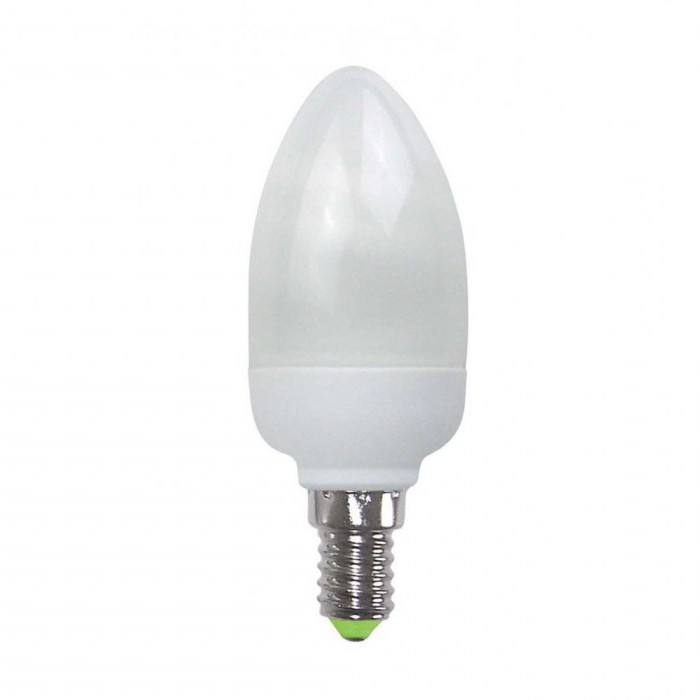
If you study the types of energy-saving lamps, you can choose fluorescent, they, according to users, can reduce energy consumption by 80%, but the light flux will be even more intense. This comparison is true for incandescent lamps. Buyers claim that such devices have a long service life, they can be used for 15,000 hours. This is 14 times more compared to a traditional lamp. These circumstances allow you to install the described devices in those places where it is difficult to change equipment frequently, here you can include rooms with high ceilings. These types of energy-saving lamps produce less heat compared to traditional lamps. That's why you can use them in fairly complex designs, namely in chandeliers and sconces. Users emphasize that in such luminaires the lamp can melt the wire or the plastic element of the cartridge.
Reviews about the uniformity of light and color temperature
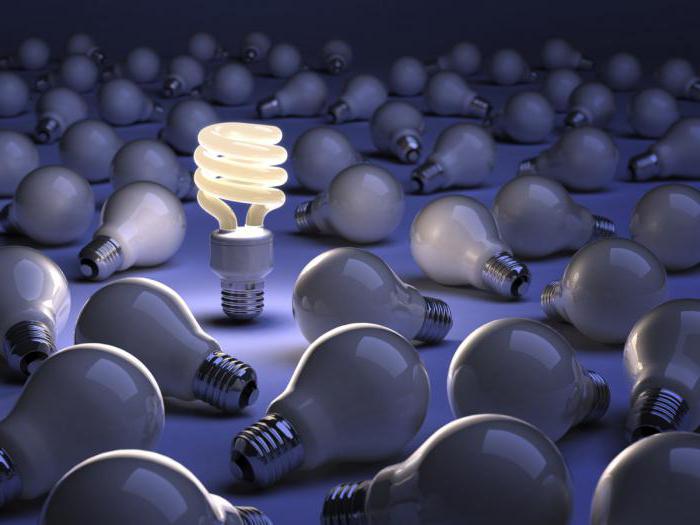
Consumers like that the light of compact fluorescent lamps is sparing for the eyes, it spreads evenly. This became possible due to the design of the device. The area of the shell of this lamp is larger in comparison with the spiral device. Consumers pay attention to the choice of color temperature. This indicates that the colors may be different. Thus, 2700 K refers to white warm light, whereas 4200 K is If there is a need to choose a cool white color, then 6400 K should be preferred. It should be taken into account that the colder the color temperature, the closer the light will be to red. If you choose compact fluorescent lamps, then, according to users, you can diversify the lighting, making it more original.
Kinds of LED devices
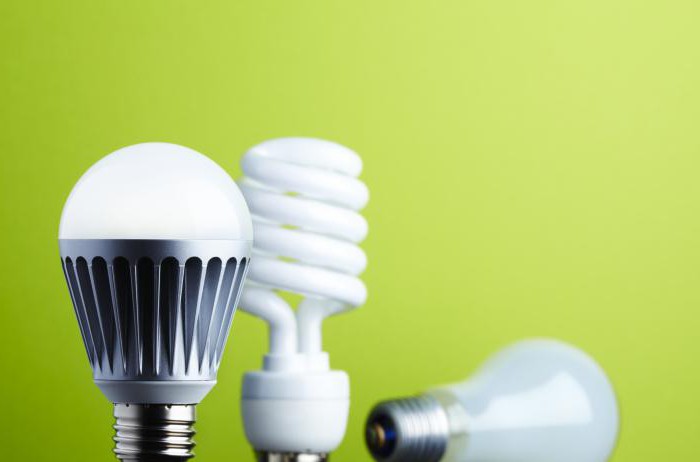
If you want to buy a lamp, the types of such devices you should definitely consider. This includes LED products, which differ not only constructively, but also depending on the field of use. According to the last criterion among such products, it is possible to distinguish Led-lamps, which are intended for lighting offices and apartments. Highlights and LEDs, designed for interior lighting. Modern industry produces LED lamps for architectural and landscape lighting. It is impossible not to mention street lamps, as well as industrial floodlights. On sale you can find even explosion-proof LED lamps.
Varieties on the design features and properties of the emitted light
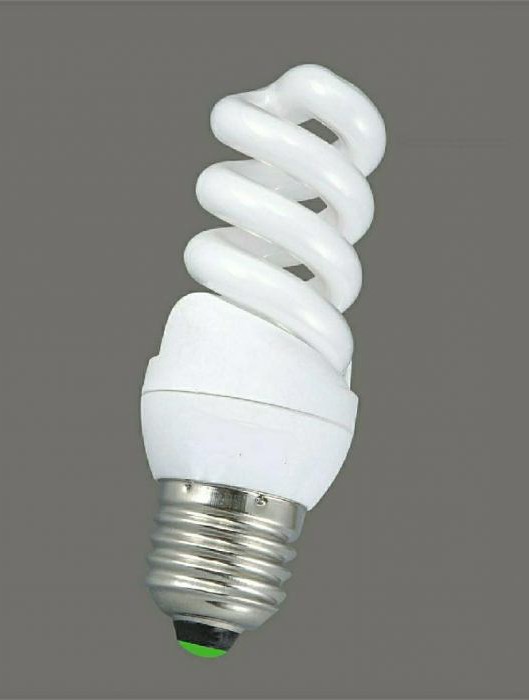
If you are considering energy-saving lamps, the species you need to study in more detail. Thus, Led-lamps are a source of diffuse quality light, which is pleasing to the eye. It is as close as possible to the illumination of so-called daylight. If there is a need to arrange a shop window, then you should choose the same Led-lamps. However, they must have directional light. For office premises, LED linear lamps are used. Their appearance resembles an oblong tube, which is equipped with a swivel cap. Such devices have a unique design that allows you to change the angle of light.
Energy-saving lamps are presented in the market by linear and compact fluorescent lamps (low-pressure discharge lamps) that contain mercury, and LED, which are environmentally friendly devices. A common, unifying characteristic is that these lighters are able to significantly save electricity, while they have a much greater light output in comparison with the usual incandescent lamps. The latter in the coming years will cease to exist, as world governments everywhere set the course for the use of energy-saving technologies. People have to make a choice between devices of the future generation. But what kind of energy-saving lamps are better than they are different and what should I pay attention to when buying? For all and many other questions, we will answer further.
has a curved shape of the bulb, allowing it to be placed in small lamps of smaller dimensions. Usually they are used in domestic conditions and replace incandescent lamps in conventional lamps. Also used in specific types of light devices. Such a lamp contains inert gases (like argon, neon) and mercury vapor, from the inside its body covers a layer of phosphor. When a high voltage is applied, electrons begin to move in it. The result of the collision of electrons with mercury atoms is invisible ultraviolet radiation, which is transformed into visible light (due to the phosphor layer).CFL consists of three parts:
- the cap with which it is connected to the network;
- Electronic ballast; electronic ballast. It includes ignition and further supports the burning of the lamp. In the same way, it converts the 220 V voltage into the one that is necessary for the operation of the CFL in the "flicker-free" mode.
- flasks.
Components of the fluorescent lamp
These components may vary, which causes the variety of the device.
Linear fluorescent lamp can be annular, straight or U-shaped. 2-chzokolnaya rectilinear fluorescent lamp looks like a glass tube. At its ends are welded special glass legs, on which the electrodes are fastened. On the inner surface of such a tube is deposited a thin layer of powder - a phosphor. It is filled with an inert gas, a dosed amount of mercury and hermetically sealed.
Such lamps differ in the diameter and length of the tube, as well as the width of the cap. The larger the tube, the more power is consumed. Usually used in offices and production.
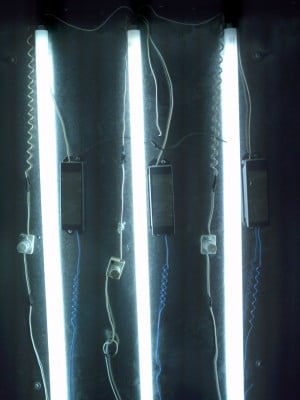
The most common are compact fluorescent lamps. Linear analogues are their "progenitors" and gradually disappear into the past. On modern devices, let's talk in more detail.
Types of compact fluorescent lamps
The domestic CFL market is formed mainly through imports. The products of such brands as General Electric, Philips, UNIEL, OSRAM, Navigator, Ecola, Compak are widely distributed. They are classified according to the characteristics of their components:
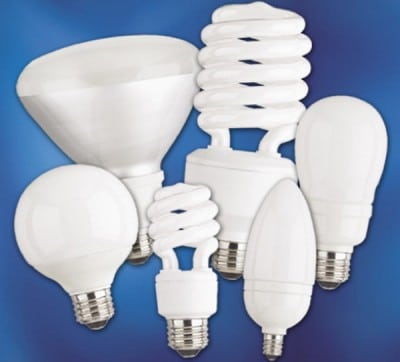
1. On the socle, which can be:
- 2D - for decorative lighting and for hermetic shower lighting, G23 - for shower, bath and wall luminaires, 2G7, G24Q1, G24Q2, G24Q3 - used in industrial and household appliances, G53 - used as energy-saving lamps for spotlights;
- E27 - for an ordinary cartridge (the most common);
- E14 - is used for a small cartridge;
- E40 - for a large cartridge.
Lamps with socles E27, E14 - installed in the cartridges of conventional incandescent lamps, since they are most simple when installed in conventional lamps. Figures 27, 14 and 40 correspond to the thread diameter in standard units. Their stated service life can be from 3 thousand to 15 thousand hours. Lamps for similar cartridges are produced with both a diffuser and an open tube.
2. By the color of the radiation, which happens:
- warm white;
- cold-white color;
- neutral white;
- daylight.
3. Also by the diameter of the flasks, which can be 7, 9, 12 and 17 mm.
4. The form of CLL is:
- U-shaped (3-foot, 4-arc, 6-tadugovye);
- in the form of a spiral (there are from 3 to 85 watts).
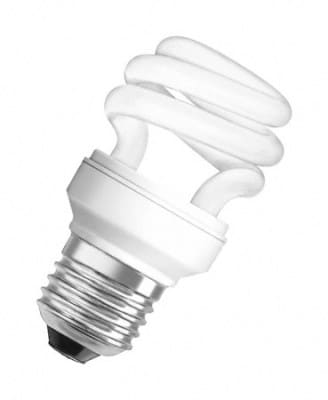
Energy saving lamp in the form of a spiral
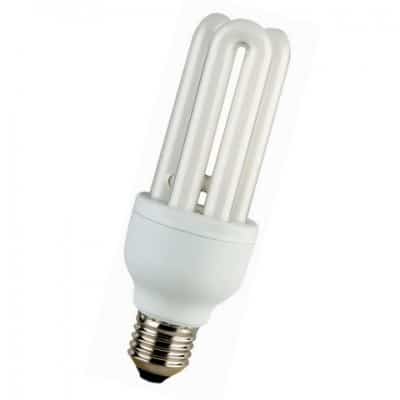
U-shaped energy saving lamp
Lamps in the form of a spiral are slightly smaller in size than the U-shaped lamps due to their length, but they are equivalent in power to them. The appearance does not affect the functionality of the lighting device. But spiral lamps are more expensive due to the more labor-intensive technology of their production.
Advantages of fluorescent lamps
- They allow to reduce electric energy expenses by 80% not to the detriment of the light flux, which remains the same as for incandescent lamps.
- Long term of work (up to 15 thousand hours). That is 6-14 times more compared to a conventional light bulb. This makes it possible to install them in those places where it can be difficult to frequent a blur of light equipment (for example, in a room with high ceilings).
- They produce less heat compared to conventional incandescent lamps. This allows the use of small CFLs of high power in particularly complex designs of fixtures, sconces, chandeliers. In such illuminating devices, the incandescent lamp is capable of melting the wire or the plastic part of the cartridge.
- The light of CFL is much more sparing for the eyes and spreads much more evenly. This is achieved through a special design of the device. After all, the area of the body of fluorescent lamps is larger than that of the filament of the incandescent device.
- CFL can have a variety of color temperature. This means that its colors can be different, for example, 2700 K - warm white light, 4200 K - daylight, 6400 K - cold-white color. The color temperature is measured on the Kelvin scale. Moreover, the "colder" the light temperature, the closer it is to red, and the "warmer" - the one to blue. Thus, using KLL you can diversify the lighting, make it much more original.

Criteria for choosing a fluorescent lamp
- The size. It is necessary immediately to estimate, whether the lamp will fit in size, whether it will enter into the chandelier or lamp holder. In other words - it is necessary to choose the right socle.
- Lamp power. This will determine the intensity of the glow. For residential premises, it is not recommended to purchase CFL with a power exceeding 15 - 25 watts, since from a more powerful device the light will be very bright.
- Life time. It is advisable to choose lamps with the longest service life.
- Colorful temperature. You need to have an idea of the color shades and choose the best one for your room. In a large hall, which usually gathers a lot of people, it is better to install a CFL of neutral white color, in a rest room, probably warm white color.
- Price. The lamps of the U-shaped bulb will be cheaper.
- Disadvantages of CFL. Whatever advantages are enjoyed by energy-saving lamps - harm from them is also possible. After all, they contain mercury, which belongs to the 1st class of danger (the most toxic). In fluorescent energy-saving bulbs, mercury is in vapor form. If it is broken, mercury will easily spread through the air. When it enters the lungs of a person, it accumulates there, spreading through other areas, and for a very long time it is not excreted, damaging health. Fluorescent lamps contain from 1 to 70 mg of mercury.
If the energy-saving lamp is broken, you need to immediately collect the remains in a container and close it tightly, process the surface on which the mercury was found with the solution of potassium permanganate. In this case, the room should be thoroughly ventilated.
Characteristics of LED lamps
The second type of lamps, which are classified as energy-saving, are LED lamps. They are produced as complete devices (fixtures) and elements of lamps (directly LED lamps). They are used in everyday life, in production, they can have different types, they are produced practically under all types of socles.
Consist of:
- Diffuser
- The LEDs themselves
- Boards to which they are attached
- A radiator that cools LEDs
- Drivers
- Ventilation holes for air circulation
- Socle
![]()
The components of the LED lamp
The light beam of LED lamps is rather narrow, about 60 degrees. Because of this, lamps are used to illuminate the rooms with diffusers that extend the luminous flux. But, for example, in table lamps, where a narrow beam of light is needed, lamps without a diffuser are used.
Types of LED devices
They differ constructively and depending on the scope of their application.
Depending on where the LED lamps are used, they distinguish:
- Led-lamps designed for general lighting of apartments and offices
- LEDs for interior lighting
- LED lamps for landscape design and exterior architectural lighting
- Explosion-proof LED lamps
- Outdoor LED lights
- Industrial LED Spotlights
According to the type of structural features of the hull, and also depending on the properties of the emitted light, distinguish:
- Led-lamps for general purpose. These are sources of the most high-quality, scattered light, pleasing to the eye, as close to daylight as possible. Used in living quarters and offices
- Led-lamps with directional light. They are used for lighting shop windows, in interior lighting
- Linear LED lamps. They look like an elongated tube with a rotating base. Due to the design, the angle of the lamp can be changed easily. They are mainly used in office buildings

There are LED lamps and the type of cap:
- Bulb (T). These are tube lamps. They are produced with a special rotating base, made in several sizes: from 15.9 mm (T5) to 38.0 mm (T12).
- The base of Edison (E). These are lamps with a threaded system that connects to a power source. It is considered to be the most common type of socle design. The marking after E denotes a specific figure that characterizes the diameter of the threaded joint. The standard sizes are E27 and E14. They are designed for operation in a 220 V network, do not require the connection of adapters.
- Pin header (G). Such lamps are connected to the cartridge by means of a pin. Fastening plugs look like a pair of contacts of a certain length and thickness (can be either standard (for 220 V) or low voltage.
- Other varieties of socles that are rare:
- S - soffitny;
- R - with recessed contact;
- In-the-stem;
- P - focusing.
The main advantages of LED lamps
- Characterized by a very long service life, reaching 100 thousand hours
- They consume little electricity (about 8 times less when compared with conventional incandescent lamps)
- They are absolutely ecological, do not contain harmful substances, they are not afraid to break them, therefore they are safe in operation. Easy to recycle.
Landmarks for buying a LED lamp
- Brightness of the glow. It is worthwhile to focus on the power of 12-20 watts.
- The color of the glow. The manufacturer usually indicates the color temperature of the lamp on the packaging. And the higher it is, the whiter the light.
- Angle of illumination. For general lighting, they buy lamps with a diffuser. For spotlights it is not needed.
- Color rendition coefficient, which must be at least 90%.
We examined the main types and all the main characteristics of energy-saving lamps. We hope that this information will help you make the right choice, purchase a lamp with the optimal parameters that are best suited for lighting a particular room.
